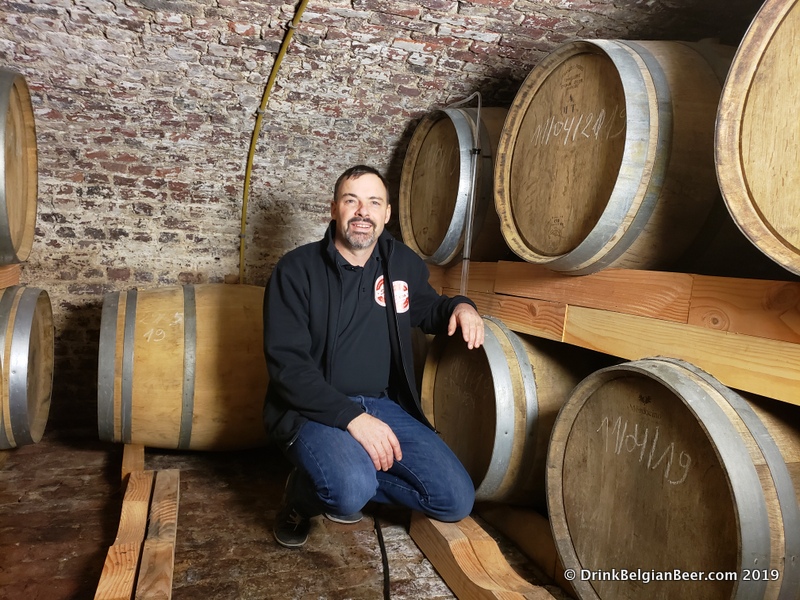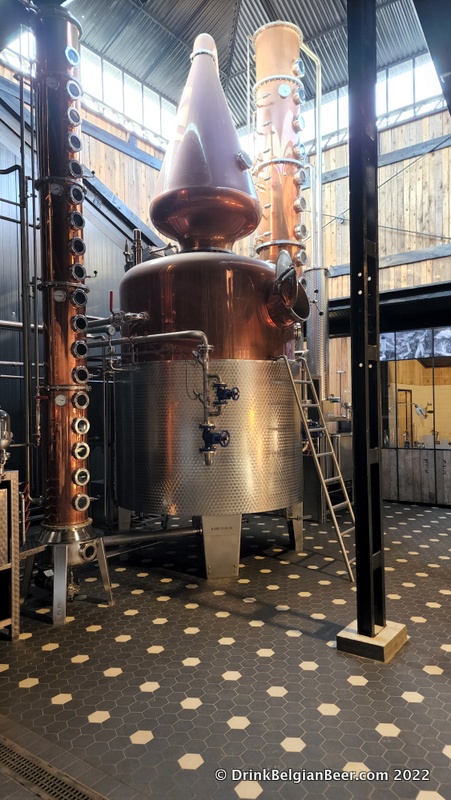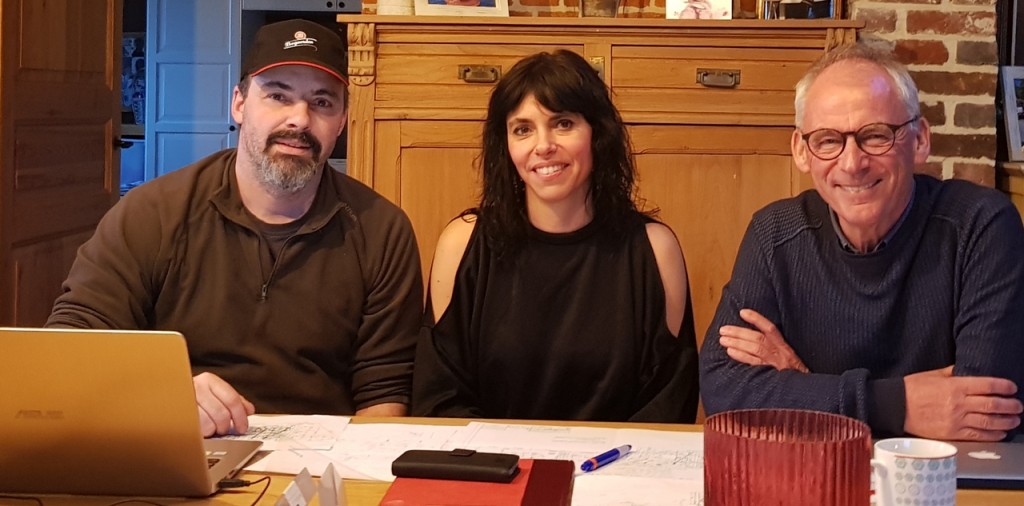Belgium has a brand new lambic brewery, right in the heart of the Pajottenland (Payottenland) and Zenne valley. De Brouwerij VAN ’T Pajottenland in Pepingen has actually been producing lambic for about 18 months now, and the site recently opened to the public. There is also an existing distillery on the same site, De Cort. The entire complex, which also has its own maltery, is called Wild Site 1670.

The partners and co-founders of the project are Koen Christiaens, brewer and owner of Brouwerij Sako in Boogarden, which I wrote about in this previous article here; Willem Van Herreweghen, the legendary brewer who founded the De Cam lambic blendery; and Manu De Cort, distiller and owner of Distillery De Cort.

Van Herreweghen’s impressive brewing career dates back decades. He worked for Stella Artois before Interbrew (now AB-Inbev) took over, and later, for Palm.

Van Herreweghen is currently a consultant for breweries in Belgium, China and U.S.A. Where he finds the time is anyone’s guess. Van Herreweghen was most recently brewmaster and Chairman of the Board of Directors of Brouwerij Timmermans, before stepping down in 2021. He still travels and consults with breweries around the world. In fact, one of his recent projects is co-developing a small malting plant in Shangri-La, Tibet.

The De Cort distillery is not new. It was founded in 2013 by Manu de Cort and his family, just 200 meters from the current site. Here is a summary of the history of their farm:

“Since the beginning of the 20th century, our farm has gone through several stages. The Huygens family first grew cut flowers, which the farmer himself then brought to the market in Brussels (with the tram that ran in the street at the time).
The conservatory that was used for this is currently converted into a malt house.
Afterwards, the family specialized in raising chickens, and eventually switched to fruit growing, with apples and pears, in the 1960s. In 2011, we bought the farm, as it was the ideal place to realize our dream: a real artisan farm distillery, which we started in 2013. Rumors are circulating that the farm was already heavily heated in the 1960s: clandestinely, as on many farms in the region at that time. Jenever was popular and grain was within reach.


After years of renovation and adjustments, the first run of spirits ran out of our German-made 1980’s Arnold Holstein boiler at the beginning of 2015. The beginning of an exciting story for our whole family. In 2021 we started to use a new part of our distillery (and brewery) 200 meters further. This we did with a brand new Holstein distillery, which was built in 2020.”

So, the distillery was moved just 200 meters to where it is now, with the new boiler and stills. The new site, with the distillery, lambic brewery, lambic aging warehouse, tasting cafe, and patio/courtyard, is called “Wild Site 1670.” Surprisingly, this is not due to some historical event or structure dating to 1670 on the site…but because 1670 is the postal code (aka zip code for those of us stateside) for Pepingen!

Clever name, gentlemen, very clever. Also, it seems that jenever was possibly clandestinely produced on the farm to avoid the heavy Belgian taxes on liquors in the past (many decades ago, and before Manu and his family purchased the farm…) which sounds vaguely familiar to someone from Virginia, USA. There was a movie made about something similar….Lawless. Yep, that’s it.


Nowadays, you can sample De Cort’s perfectly legal and taxed liquors on-site, or purchase them to take home.

As to the cooperation between Distillery De Cort and De Brouwerij VAN ’T Pajottenland, Manu De Cort told us that the hot water used to distill his spirits is recovered and used by the brewery, so no energy or water is wasted. See the video below for his remarks.
After touring the distillery, we headed over to the brewhouse at Wild Site 1670, De Brouwerij VAN ’T Pajottenland. The 30 hectoliter (25.5 U.S. barrel) system was built for Brouwerij Sako in China in 2019, and delivered in 2020.




About the brewery, Willem Van Herreweghen had this to say: “This brewery is state-of-the-art, with a traditional coolship. With this brewhouse, both traditional lambic, as well as top fermented classic beers (ales) can be produced. This gives us a lot of flexibility in what we can do.”

In fact, their intention is to produce not just lambic but also “wild” beers. Some will be made with brettanomyces, and others will be blends of lambic with other styles of beer, and also, ciders.


Willem Van Herreweghen and Koen Christiaens told me that their goal is to utilize only locally sourced ingredients for their beers, such as malts like barley and unmalted wheat, as well as hops, fruits, and yeasts. For the time being, their malts come from two Belgian malteries, Dingemans near Antwerp, and La Malterie du Château (Castle Malting) in Beloeil in Hainaut Province. Check out the video below for more info.
The first two commercial products of the brewery are both such blended beverages. Wild Adam is a cider blended with lambic. It is described as such: “Two Pajotse (Payottenland) friends, Andy and Manu, come up with the idea of mixing Adam’s spontaneous discovery from history at the time, the apple cider, with another naturally fermented nectar from the Pajottenland, called lambic. The fact that these two are compatible and merge harmoniously is due to nature, which provides something unique in the rolling Pajottenland in the form of yeasts and bacteria.”
I tasted Wild Adam on two occasions during my recent trip, at De Bascule, which I wrote about in this previous article here, and then in the brewery/distillery tasting cafe, on their beautiful patio. It is a very tasty blend of cider and lambic, with a mild to medium tartness, and a funky cider and lambic-like aroma. It is medium bodied and easy drinking, largely due to its dryness and its not too high 6.5% abv.


The next beverage in the De Brouwerij VAN ’T Pajottenland/Distillery De Cort lineup is “Wilde Stout VAN ‘t Pajottenland” which is a dark stout aged in former bourbon barrels, with brettanomyces yeasts added. It is described as such: “Our latest creation is a Wild Stout. A stout thought indeed, as it is not the most common beer, but in addition to wild, we sometimes dare to come out as stout. And also created by spontaneous fermentation. The result is impressive: a unique creation, perfectly balanced and matured in old Bourbon barrels.”

This 7% abv brew is a very pleasing, mildly tart and funky stout. Only 1954 bottles in the 75 cl size were produced of the first batch.

The lambic and other barrel aging warehouse is quite obvious from the brewery courtyard, as it has a “House Casks” sign out front, and an old red British double decker bus sits right beside it. The cool factor of Wild Site 1670 is very high!

We then went inside the cask warehouse for a visit and tasting. This is always my favorite part of visiting lambic breweries and blenderies!

“The oldest lambic we have that was brewed here is from 18 months ago, and we also have lambic from Brouwerij Sako that is three years old,” remarked brewer Koen Christiaens. Partner Willem Van Herreweghen added: “We will bottle an Oude Geuze sometime later this year, for release sometime in 2023.”

Now, it was time to taste some lambics! There is a small tasting bar set up in the warehouse where lambic can be pulled directly from a barrel and served via hand pump. The 18 month old lambic was very good: soft, with a mild tartness and mild funk. A very promising brew.


Koen then poured us a sample of year old kriekenlambiek, from another barrel. I really enjoyed this brew; it was fruity, funky, and as the lambic, with a mild tartness.

There are already many racks of full bottles in the cask warehouse, as you can see in the photo below.



We then headed upstairs to the bourbon barrel aging space. Note that Distillery De Cort, of course, does not make bourbon here, as that is a whiskey native to the USA. But De Cort has a lot of former U.S. made and used bourbon barrels, as distiller Manu De Cort is a bourbon fan, and likes the effect of aging his spirits, and the brewery’s beers, in former bourbon barrels.



We then walked back over to the tasting room, and tasted the Wild Adam and Wild Stout, and then several of Manu De Cort’s liquors. De Cort Belgian Beer Brandy was first. This one is distilled from a strong blonde Tripel ale, presumably from Brouwerij Sako. It is, not surprisingly, aged in former bourbon barrels, for three years, and has 42% alcohol by volume/84 proof. This one tastes like a barrel-aged Jenever, and is very good.

As Manu De Cort says in the video below, he could legally refer to this as a whiskey, but he preferred to call it a “Belgian Beer Brandy” in keeping with the cooperation between beer and liquors at Wild Site 1670.




Business has been good at Wild Site 1670 since they opened on Sundays this summer. They had an open door day on Sunday, September 18th, and Manu De Cort remarked that there were over 1,000 visitors in the tours and tastings that day, despite it being a rainy one.


Wild Site 1670 is located at Boekhoutstraat 20 in Pepingen, and is currently open on Sundays beginning at 11 am until about 7 pm. Tours of the site are offered at 2 pm, and last about an hour and a half. See here for full details. I highly recommend a visit to this special place!
As far practical matters, such as how to get to Wild Site 1670, having a Belgian or other European friend drive would be ideal. Another way would be to hire a professional driver who knows the area, as car rentals and fuel can be expensive, and Belgium’s drunk driving laws are very strict.
One such person is Patrick Van der Spiegel. As a resident of Halle, ten miles southwest of Brussels in Belgium’s lambic country, he has lived his life savoring and enjoying lambic brews. Patrick has two projects, “The Land of Geuze” and “Lambic Tours” which both have Facebook and Instagram pages. The Lambic Tours website is here.

To sum up, Patrick Van der Spiegel organizes tours to lambic breweries, geuze blenderies, and traditional Belgian pubs in and near the Pajottenland and the Zenne Valley. Patrick guides these tours himself, and can do so in English, Dutch, and French. In addition, there is the possibility to pair these tours with guided tours at breweries or blenderies, with professional tour guides, or lambic brewers/blenders. These tours typically include tasting samples of multiple beers, and an optional lunch or dinner for the whole group.
If you are interested in these custom guided tours, feel free to fill in the contact form on their website (lambictours.com) or send an email to patrick@lambictours.be. It is also possible to send private messages through their Instagram and Facebook pages.
Patrick’s lambic tours can be summed up in one word: Marvelous!


Leave a Reply